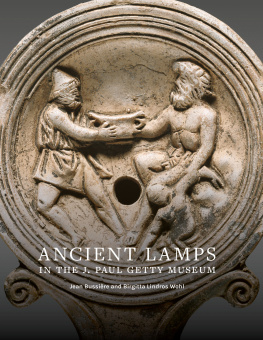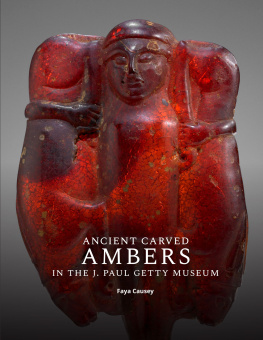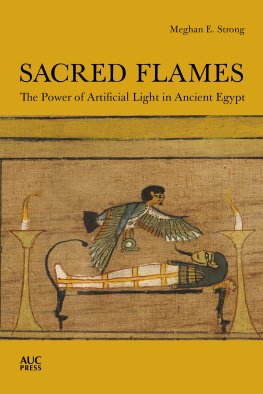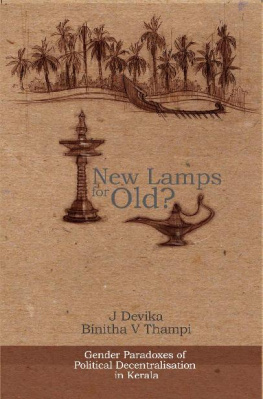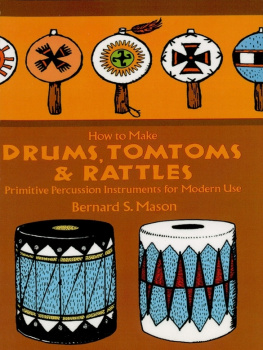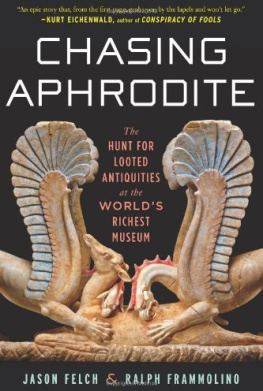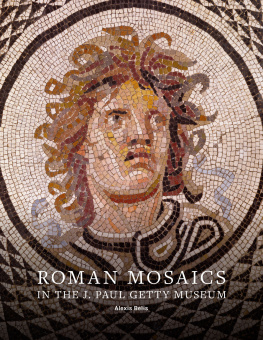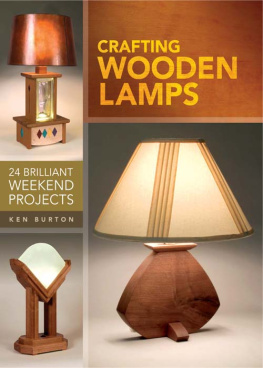Ancient Lamps in the J. Paul Getty Museum
Jean Bussire and Birgitta Lindros Wohl
The J. Paul Getty Museum, Los Angeles

Contents
Directors Foreword
As far back as prehistoric times, dwellings have yielded simple stone containers that held fuel and a floating wick. With the growing complexity of the built environment, a great variety of lighting implements, from clay saucers and shell bowls to precious-metal vessels, are found in Near Eastern and Aegean sites during the Bronze Age. Over time, lamps became both more technologically sophisticated and, by the Hellenistic period, more elaborately decorated with figurative and other iconographies, as was appropriate to their widespread use in homes, markets, temples, palaces, burials, and sanctuaries. This trend reached its apogee during the Roman imperial period, from which derives the bulk of the Getty Museums collection, published here for the first time.
Oil lamps reveal more about life in antiquity than their practical function as illumination devices may suggest. Like pottery and coins, their typological development has been documented to the degree that excavated finds give archaeologists a reliable tool for dating. Manufacturers frequently marked their products with signatures and stamps, allowing the trade from factory to customer to be mapped over considerable distances. Although usually classed as a mundane instrumentum domesticum, portable sources of light were essential fixtures in commercial districts and architectural interiors. When suspended from brackets and candelabra, a lamps flame produced an animated chiaroscuro effect on sculptures, wall paintings, textiles, and furnishings. Such intimate ambiances led some ancient authors to personify lamps as confidants of their owners private moments. Their placement in sanctuaries and graves emphasizes the role of divine radiance in ceremonies involving fire and light.
Most of the Gettys lamps were acquired from Hans-Klaus Schller, a connoisseur with a sharp eye for regional variants and unusual imagery. Heading the series, which ranges from around 800 B.C. to A.D. 800, is a bronze lamp common in Nuragic sites in Sardinia. Taking the form of a boat, it is emblematic of the seaborne metal trade that connected eastern and western Mediterranean cultures. Greek wheel-made types with an open oil reservoir were eventually eclipsed by molded lamps with relief designs on the now-covered basin. A majority of our lamps have a decorated discus and come from prolific Roman imperial workshops, which met the ubiquitous demand for lighting. In the late Roman and Byzantine eras, Judeo-Christian symbols and inscriptions give tangible signs of the spread of new religious beliefs. Several early Islamic examples witness the longevity of a traditional form, which continued to be made in Syria, Palestine, and Egypt between the seventh and eleventh centuries.
Notable for their great diversity, the lamps catalogued here depict nearly three hundred distinct iconographic motifs, reflecting changing fashions and a rich repertoire of images drawn from mythology and religion, the occupations and entertainments of daily life, and the natural world. Some 250 vessels represent a form or a decor that is either unparalleled or only approximated by other known types. Among them, a unique lamp decorated with a male head in gold foil and azure glass recalls the golden votive lamps mentioned in classical literature. An altar-shaped lantern decorated with reliefs of Olympian gods was a dual-purpose thymiaterion, whose flames diffused both light and the fragrance of the burning incense.
We are deeply indebted to the authors, who each brought their profound knowledge and commitment to this project. It is a source of great sadness that Jean Bussire, whose extensive experience was critical to the identification of our lamps from North Africa, Asia Minor, and other production centers, did not live to see his contribution published. We are therefore all the more grateful to Birgitta Lindros Wohl, a longtime friend of the Getty Villa, who undertook the task of researching the Greek and metal lamps, and of overseeing the final editorial stages. Our thanks are due also to the Getty Museums curators of Antiquities, notably Claire Lyons, as well as the departments of Antiquities Conservation and Imaging Services, and to Getty Publications for realizing the authors comprehensive typological study so successfully as an online resource. Available in digital and print formats, Ancient Lamps in the J. Paul Getty Museum promises to be a valuable sourcebook for students and specialists in lychnology, archaeology, and social life in classical antiquity.
Timothy Potts
Director
The J. Paul Getty Museum
Acknowledgments
A project of the scope of the present work necessarily accumulates many debts of gratitude. It is a pleasure to record these debts at this final point.
First, we were fortunate to be able to study the material in the inspiring environment of the Getty Villa in Malibu and to be guided through the commendably organized and recorded collection by a friendly and helpful staff. Our thanks go first to Kenneth Lapatin, Curator of Antiquities, for his support of the project; he was always ready to accommodate us in the midst of many other museum duties. Former Senior Curator Karol Wight enthusiastically furthered the project at every turn during her time as head of the Antiquities Department. Their colleagues, especially David Saunders, Jens Daehner, Nicole Budrovich, and Mary Louise Hart, responded with efficiency and patience to our need for revisiting both items and issues. We are especially grateful to Claire Lyons, Curator of Antiquities, who shepherded our manuscript through the process of publishing it as an online catalogue.
Special thanks go to the Museums departments of Antiquities Conservation and Imaging Services, both further acknowledged in the context of the below. The contributions and expertise of their staffs have greatly enhanced this catalogue. Marina Belozerskaya, formerly of Getty Publications, helpfully responded to many questions at an early point. The greatest debt of gratitude we owe, however, to our editor and friend, Benedicte Gilman. We regard ourselves very fortunate to have had access to her unequaled professional competence and standards, as well as her amazingly sharp eye for every detail. She guided us firmly and kindly through the intricacies of the process to a much improved end product and managed with diplomacy to make the years-long process in the end a pleasure of enlightenment.
We are also grateful to the staff of Getty Publications who helped to make this catalogue a reality, most particularly Greg Albers and Eric Gardner, who oversaw the making of the digital publication with a strong assist from interns Gail Acosta and Nick Geller; Karen Levine, Rachel Barth, and Kim Wilkinson for their editorial and logistical expertise; and Elizabeth Chapin Kahn for production supervision.
The Getty Research Institute has provided a haven for scholarly work. We are most grateful to its staff, which was always ready to provide service with material desired, as well as to answer a variety of questions in response to our needs.
Several institutions outside the United States also deserve our gratitude for assistance and welcoming cooperation. Some were visited by Jean Bussire alone, others by both authors. At the Rmisch-Germanische Kommission, Frankfurt, our special thanks go to its director, Dr. Susanne Sievers, and to its chief librarian, Dr. Gabriele Rasbach; at the Rmisch-Germanisches Museum, Cologne, we thank Professor Hansgerd Hellenkemper, now retired, and Dr. Eva Maria Cahn-Klaiber, whose assistance and information concerning the rich lamp collection of that museum were most helpful. At Bochum University Museum, its head curator, Dr. Cornelia Weber-Lehmann, amiably facilitated access to the Schller collection there and provided valuable information, while Karin Goethert allowed us to reproduce some figures from her catalogue; our further thanks go to the Maison Mediterranenne des Sciences Humaines, Aix-en-Provence; the Maison de lOrient, Lyon; and the Centre Archologique de Lattes (UMR 5140, CNRS). Our special thanks to librarians Marie-Paule Seure and Blandine Nouvel (Aix), and Vronique Humbert and Christine Lam (Lattes).

